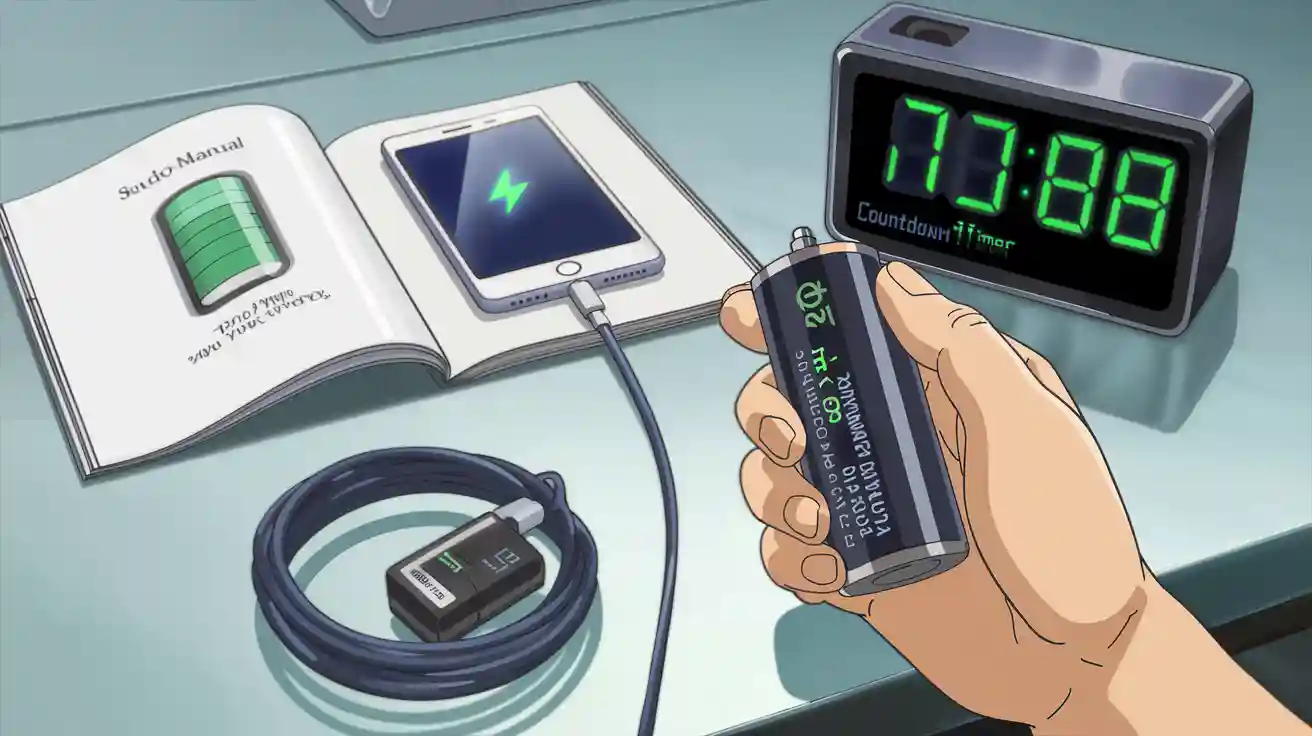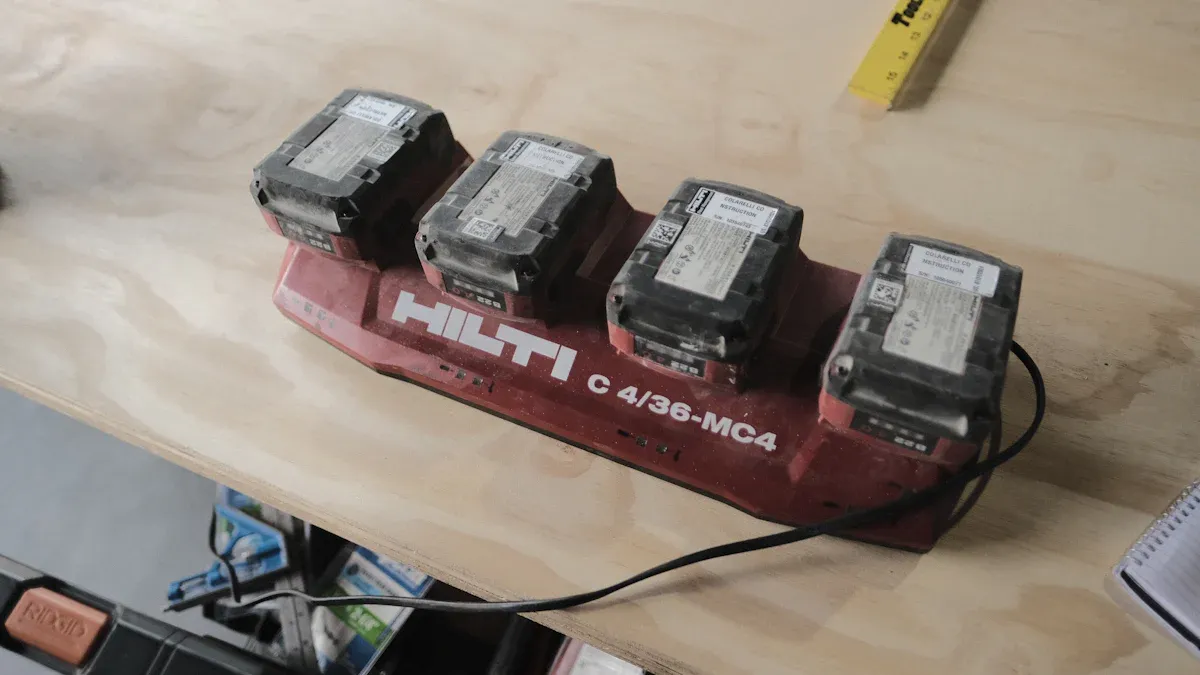How long the Lithium ion battery first time charging?

You do not need to charge your lithium ion battery for an extended period the first time. Most modern lithium-ion batteries reach full charge in 2 to 4 hours. Manufacturers recommend the following average charging times:
| Battery Type | Recommended Charging Time |
|---|---|
| Lithium-ion (laptops, tools, cars) | 4-6 hours |
| Lithium polymer (LiPo) | 3-5 hours |
| Lithium iron phosphate (LiFePO4) | 6-10 hours |
You will not damage your device by unplugging it when full. Always follow the instructions that come with your device for the best results.
Key Takeaways
- Charge lithium-ion batteries for the first time based on device type: 1-3 hours for small devices and 4-6 hours for larger ones.
- Always use the charger that comes with your device to ensure safe and efficient charging.
- Avoid myths: modern lithium-ion batteries do not need long initial charges. They come pre-charged and ready to use.
Lithium Ion Battery: First Time Charging

Recommended Charging Time
You might wonder how long you should charge a lithium ion battery for the first time. The answer depends on the device and battery size. For small consumer electronics, such as a mobile phone battery, the typical charging time during the first charge ranges from 1 to 3 hours. Larger batteries, like those in laptops or electric vehicles, usually require 4 to 6 hours for a full charge the first time. Most modern chargers automatically stop supplying power when the battery reaches full capacity, so you do not need to worry about unplugging at an exact time.
- Small devices (mobile phone battery, tablets): 1–3 hours charging time
- Laptops, power tools, and electric vehicles: 4–6 hours charging time
You should always use the charger that comes with your device or one recommended by the manufacturer. Using the correct charger ensures safe and efficient charging every time. If you use a third-party charger, make sure it matches the voltage and current specifications for your lithium-ion battery.
Myths About First Charge
Many myths surround the first time charging of a lithium ion battery. Some people believe you must charge a lithium-ion battery for 8 to 12 hours or even 24 hours before first use. This advice comes from older battery technologies and does not apply to modern lithium-ion batteries. You do not need to charge for an extended time to "activate" the battery. In fact, lithium-ion batteries come pre-charged and ready to use.
| Myth | Evidence Disproving the Myth |
|---|---|
| New lithium-ion batteries require multiple 12-hour charge cycles to activate. | Lithium-ion batteries come pre-charged and can be used immediately without extended charging. Prolonged charging can lead to overcharging risks. |
| Overcharging a lithium-ion battery is harmless. | Overcharging can damage the battery, leading to gas generation and potential rupture. Research shows it can reduce lifespan significantly. |
| You should let your battery die completely before charging it. | Allowing complete discharge can damage lithium batteries. It's best to keep them between 20% and 80% charge. |
You may also hear that charging your mobile phone battery overnight will degrade it faster. This is misleading. Modern devices include a Battery Management System (BMS) that prevents overcharge and protects the battery. However, it is still a good habit to unplug your charger once the battery is full, especially if you use a third-party charger.
Tip: Avoid letting your lithium ion battery discharge completely. Keeping the charge between 20% and 80% helps extend battery life.
Manufacturer Advice
Manufacturers provide clear guidance on how to charge a lithium battery for the first time. You should always follow the instructions in your device manual. Most recommend using the original charger and avoiding extreme temperatures during charging. Charging your battery in a stable environment between 10°C and 45°C (50°F to 113°F) helps prevent performance issues and safety hazards.
- Place the battery pack away from heat sources to avoid thermal runaway, which can occur at high temperatures.
- Use only the charger specified for your lithium-ion battery.
- Remove the battery from the charger once it is fully charged.
- Never charge your mobile phone battery or other lithium-ion battery in direct sunlight or freezing conditions.
Scientific studies show that overcharging, even during the first charge, can cause capacity degradation and increase safety risks. Overcharging leads to internal stress and damage to the battery’s components, which can shorten its lifespan and, in rare cases, cause failure.
| Study Title | Focus | Findings |
|---|---|---|
| Life-extending optimal charging for lithium-ion batteries based on a multi-physics model and model predictive control | Investigates optimal charging methods for lithium-ion batteries | Proposes a life-extending optimal charging method that balances charging speed and battery lifetime, addressing degradation issues. |
| Findings | Description |
|---|---|
| Capacity Degradation | Intermittent overcharging accelerates capacity degradation and impedance rise in cells. |
| Failure Mechanism | Cells fail after about 100 cycles due to cumulative gas production from side reactions. |
| Monitoring Method | A method is proposed to predict battery failure by monitoring changes in surface temperature, charging capacity, and current. |
| Overcharging Effects | Higher cut-off voltage leads to short-term battery failure; lower voltages cause noticeable capacity fade. |
| Damage Mechanism | Internal stresses during overcharging cause extensive damage to cathode particles. |
| Safety Risks | Degradation of mechanical properties and thermal stability introduces significant safety risks. |
Following best practices for charging, such as using the right charger and monitoring the charging time, helps you avoid these risks. You protect your lithium ion battery and ensure it delivers reliable performance every time you use it.
How to Charge a Lithium Battery for the First Time
Step-by-Step Process
Charging a lithium-ion battery for the first time requires careful attention to detail. You can follow these steps to ensure a safe and effective initial charging process:
-
Read the Manufacturer's Instructions
Begin by reviewing the user manual or documentation provided with your device. Manufacturers often include specific guidelines for the initial charging process. -
Check the Initial Charge Level
Inspect your device to determine the battery's current charge. Some batteries arrive partially charged, while others may be fully discharged. -
Use the Correct Charger
Select the charger that came with your device or one recommended by the manufacturer. Using an incompatible charger can damage the battery or create safety risks. -
Charge in a Suitable Environment
Place your device in a cool, dry area away from direct sunlight. Avoid charging in extremely hot or cold conditions. -
Connect the Battery to the Charger
Insert the battery into your device if it is removable. For non-removable batteries, simply connect the device to the charger. -
Let it Complete the First Charge Cycle
Allow the battery to charge from its current level to 100% without interruptions. This step helps calibrate the battery and sets its maximum capacity. -
Avoid Interrupting the Charge
Do not disconnect the charger until the battery reaches full capacity. Interruptions during the first cycle can affect long-term performance. -
Don't Overcharge
Unplug the charger once the battery is fully charged. Continuous charging after reaching 100% can shorten battery lifespan. -
Regularly Maintain the Battery
Follow recommended charging and discharging practices. Avoid overdischarge and overcharging to keep your battery healthy.
Tip: Let your battery rest for 10–15 minutes after its first use before recharging. This practice helps stabilize the battery chemistry.
Safety Tips
You must prioritize safety during the initial charging process. The following precautions help prevent accidents and extend battery life:
- Use only the charger designed for your lithium-ion battery type and capacity.
- Monitor the battery temperature during charging. If you notice overheating, disconnect the charger and move the device away from flammable materials.
- Charge your battery in a well-ventilated space. Avoid charging near heat sources or in direct sunlight.
- Never pause the first charge before it completes. Interruptions can cause calibration issues and reduce battery performance.
- Avoid charging below 0°C or above 45°C. Extreme temperatures can damage the battery and increase safety risks.
- If your battery overheats, place the device on a non-combustible surface. For severe cases, remove the battery and place it outdoors. Use a foam extinguisher, CO2, or dry chemical for small fires.
Note: Always read the instruction manual for specific safety guidelines. Manufacturers provide important information tailored to your device.
Factors Affecting Charging Time
Several factors influence the charging time of your lithium ion battery during the initial charging process. Understanding these variables helps you optimize battery health and performance.
| Factor | Impact on Charging Time | Impact on Battery Life |
|---|---|---|
| Battery Capacity | Larger batteries require more time to charge. | Higher capacity may support longer lifespan if managed well. |
| Charger Output | Higher amperage and voltage reduce charging time. | Fast charging method may decrease longevity if used frequently. |
| Charging Rate | Charging at 0.5C extends charging time. | Slow charging improves longevity. |
| Environment | Low temperatures slow charging. High temperatures speed up charging but increase risk. | Extreme conditions can cause overdischarge and degrade battery. |
| Battery Age | Older batteries may charge more slowly. | Aging increases risk of overdischarge and capacity loss. |
- Charging at a slower rate (0.5C) is safer and extends battery life.
- Fast charging method (1C) reduces charging time but may impact battery longevity.
- Chargers should provide a current between 0.5C and 1C of the battery’s capacity.
- Low temperatures increase electrolyte viscosity, slowing ion conduction and raising internal resistance. Charging speed decreases in cold environments.
- High temperatures accelerate chemical reactions, increasing charging speed but raising the risk of overheating and swelling.
- High humidity can cause moisture accumulation, leading to short circuits and reduced battery life.
Callout: Always avoid overdischarge and overcharging. Keeping your battery between 20% and 80% charge helps maintain optimal performance.
You can keep your lithium ion battery healthy by following these best practices:
- Charge up to 80% to reduce capacity loss.
- Avoid leaving your device plugged in after charging.
- Use a slow charger when possible.
- Check your device manual for specific instructions.
- Set charging profiles correctly and monitor battery health.
Feel free to ask questions or connect for partnership details. Your battery is designed for easy, safe use.
-

 May.2025.11.24Ternary Lithium Battery vs Lithium-ion: Complete Comparison Guide (2025 Edition)Learn More
May.2025.11.24Ternary Lithium Battery vs Lithium-ion: Complete Comparison Guide (2025 Edition)Learn More -

 May.2025.11.214S2P 18650 14.8V Battery: Complete Technical Guide, Specs, Applications & SafetyLearn More
May.2025.11.214S2P 18650 14.8V Battery: Complete Technical Guide, Specs, Applications & SafetyLearn More -

 May.2025.11.18PCM vs BMS in Lithium Batteries: What’s the Difference and Which One Do You Need?Learn More
May.2025.11.18PCM vs BMS in Lithium Batteries: What’s the Difference and Which One Do You Need?Learn More -

 May.2025.11.17Custom Li-ion Battery Design for Medical Devices (2025 Comprehensive Guide)Learn More
May.2025.11.17Custom Li-ion Battery Design for Medical Devices (2025 Comprehensive Guide)Learn More -

 May.2025.11.17The Future of Lithium-Ion Batteries: Innovation, Sustainability, and Global Market TrendsLearn More
May.2025.11.17The Future of Lithium-Ion Batteries: Innovation, Sustainability, and Global Market TrendsLearn More















